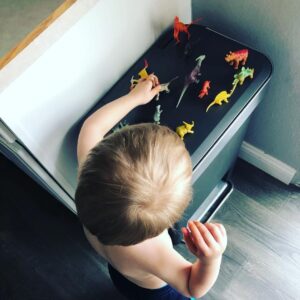by Kayla Myers, Family Peer Supporter
October 31, 2023
Sensory Processing Disorder was something I was very naive to before having a child diagnosed with Autism. There are 1 in 20 people affected by this every day. Someone living with SPD might be obvious to spot (like my son), while others, you might never know unless you were told. We most commonly think that our senses are made up of these components: sight, smell, hearing, taste, and touch. But there are eight senses and the other three are proprioception, interoception, and vestibular. When someone has a diagnosis of SPD, their brain doesn’t “process” the senses from external sources at that direct moment so it can feel very bombarding when stimulation occurs (basically when the sense is processed by the brain finally). This can cause those affected to either avoid or seek sensory stimulation so they can regulate their body.
 My son is affected greatly with Sensory Processing Disorder. He is one of the ones where it is visual, and he seeks out sensory input constantly. The best way this was described to me was that he is constantly trying to detect where his body is in space. He has very repetitive movements like flapping his hands, vocal stimming, jumping, putting options in his mouth that aren’t for eating, random need to run, and many others. This term for most of this is called stimming. But they are things that regulate his body and make his brain feel “good”. A lot of the time, people with Autism/Sensory Processing Disorder feel the need to tone down their stimming in public or around neurotypicals. It is important to encourage them to have the space to stim so they can be free in their own skin. For someone who is unable to communicate with words, some of my sons stimming can be quite loud (makes my sensory profile a little over stimulated at times LOL). The senses we experience every day can be very overwhelming to someone with SPD. Food can make them physically sick, smells can give them a headache, pain can be nonexistent, and these are just a few examples. I thought it was important to shed some light on what this can look like and how it can feel living with this disorder. It is not a walk in the park and must be incredibly difficult to navigate a world that your body/brain is trying to catch up with.
My son is affected greatly with Sensory Processing Disorder. He is one of the ones where it is visual, and he seeks out sensory input constantly. The best way this was described to me was that he is constantly trying to detect where his body is in space. He has very repetitive movements like flapping his hands, vocal stimming, jumping, putting options in his mouth that aren’t for eating, random need to run, and many others. This term for most of this is called stimming. But they are things that regulate his body and make his brain feel “good”. A lot of the time, people with Autism/Sensory Processing Disorder feel the need to tone down their stimming in public or around neurotypicals. It is important to encourage them to have the space to stim so they can be free in their own skin. For someone who is unable to communicate with words, some of my sons stimming can be quite loud (makes my sensory profile a little over stimulated at times LOL). The senses we experience every day can be very overwhelming to someone with SPD. Food can make them physically sick, smells can give them a headache, pain can be nonexistent, and these are just a few examples. I thought it was important to shed some light on what this can look like and how it can feel living with this disorder. It is not a walk in the park and must be incredibly difficult to navigate a world that your body/brain is trying to catch up with.Sensory processing disorder has brought joy and discomforts to my sons’ life. But I will say, I am thankful that he reminds me daily to stop and acknowledge a sense. We get so busy as adults and parents; it is hard to just be still and feel. It is important to regulate ourselves as well.

